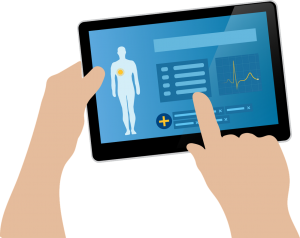
Patients are often reluctant to go for follow-ups to their gastroenterologists due to commuting great distances or getting stuck in traffic for hours. Some people even tend to ignore their appointments if they think they’re feeling just the slightest bit better.
Thanks to advancements in medical technologies, the good news is that now, patients who would otherwise spend a full day traveling to see their gastroenterologists can remotely visit from the comfort of their homes.
So, what is the impact of telehealth services for gastroenterologists?
Along with medical billing and revenue cycle management services, any telehealth software you choose to purchase must be safe and HIPAA-compliant since sensitive patient information is being transferred and shared regularly. Gastroenterologists and related practices are not advised to use other software, such as Skype or FaceTime for medical appointments due to the sensitivity of the information involved.
CMS increased reimbursement for telephone evaluation and management (E/M) codes 99441-99443 to the level of office/outpatient E/M codes 99212-99214 ($46-$110) as of April 30, allowing more people to use telemedicine. This makes it easier for patients to see their gastroenterologists without having to make the trip physically to their clinic.
Also, due to COVID-19, rules have expanded telehealth coverage to all Medicare beneficiaries, not just those with the novel coronavirus. This also entails payments for telehealth services to a variety of settings in addition to existing coverage for physician offices, skilled nursing facilities, and hospitals, allowed reporting for new and existing patients, and allowed two-way, real-time audio/visual telehealth services.
The following are some of the big changes that you should know about if you’re a gastroenterologist;
During the PHE, doctors, clinical psychologists, and nutritionists, may offer telemedicine. Many states in the US have reduced telehealth standards as part of COVID-19 emergency declarations.
Gastroenterologists and related fields need to know that Medicare will accept audio-only telephone E/M encounters as telehealth, but they must be documented using the 99441-99443 telephone E/M codes. Codes 99201-99215 can only be used to register two-way, real-time audio/visual E/M visits.
Consequences for the Patient Copay Standard Telemedicine appointments are still subject to Medicare copays and deductibles, although there is some flexibility. Health providers will be able to waive or decrease cost-sharing* for telehealth appointments during the coronavirus emergency. On the other hand, beneficiaries are still responsible for cost-sharing for these services if the practitioner does not waive cost-sharing. Beneficiaries should be informed about any cost-sharing arrangements that may be in place.
The portion of your insurance-covered expenditures that you pay out of pocket. This phrase refers to costs like deductibles, coinsurance, and copayments, but it excludes premiums, balance billing amounts for out-of-network providers, and the cost of non-covered treatments.
Telephone office visits and consultations are among the services offered by a qualified provider utilizing an interactive two-way telecommunications system with real-time audio and video or an audio-only call. During the COVID-19 PHE, clinicians can record telehealth visits for both new and existing patients on any real-time, non-public communication platform, such as FaceTime and Skype, and payment is the same as for in-person E/M visits.
During the COVID-19 crisis, CMS temporarily eliminated all criteria requiring recording of medical history and/or physical exam in the medical record, and E/M level selection can be based on medical decision making (MDM) or average time indicated in the CPT code description.
Choose the relevant code (99201-99215) and enter the POS that would have been recorded if the service had been provided in person (e.g., 11-Office, 22-Hospital Outpatient, 23-Ambulatory Surgery Center). This will allow Medicare to reimburse the service at the same rate as if the service had been provided in person at the provider’s location (i.e., facility or non-facility). To indicate that the service was provided via telehealth, providers must add telehealth modifier 95 to claim lines. The “facility” fee will be paid to providers who continue to use the generic telehealth POS 02 code.
Time-based CPT codes are used to define telephone E/M. Payment for telephone E/M codes 99441-99443 is comparable to 99212-99214 as of March 1, 2020, and can be used for new or established patients during the PHE. Use modifier 95 and the POS where the visit would have occurred in person prior to the public health emergency (e.g., 11-Office, 22-Hospital Outpatient, 23-ASC). Before reporting the codes for non-Medicare beneficiaries, make sure your commercial payers cover these services.
JBF Medical Billing, LLC. is an experienced and reliable billing service exclusively for gastroenterologists and gastroenterologist-related practices. Our medical billing software links easily to most of the EHR (electronic health records) software that physicians use. JBF Medical Billing LLC. is also a proud member of the American Gastroenterological Association (AGA), the American Association of Healthcare Administrative Management (AAHAM), and the American Medical Billing Association (AMBA), so you can rest assured all of your Revenue Cycle Management and HIPAA Compliance are taken care of by the experts.
© 2024 JBF Medical Billing. All Rights Reserved.
Affiliated with JBF Suite LLC.